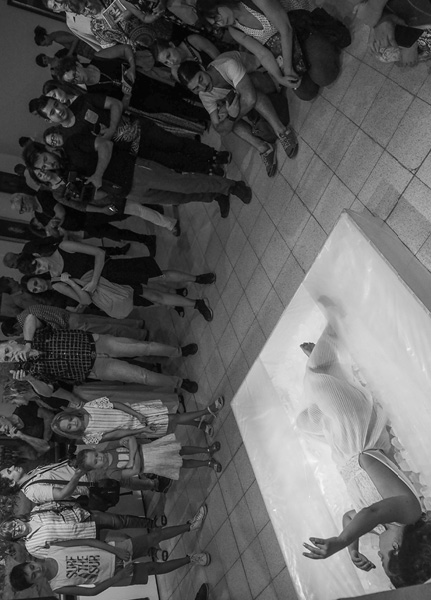
FAKIR
first performed on March 9, 2018
Museo Provincial de Bellas Artes “Emilio Pettoruti,” La Plata, Buenos Aires, Argentina
performed once in 2018
MÓNICA ISABEL MENACHO
Victoria Calvente, David Menacho
324561850m324561850o324561850n324561850i324561850c324561850a324561850m324561850e324561850n324561850a324561850c324561850h324561850o324561850@324561850g324561850m324561850a324561850i324561850l324561850.324561850c324561850o324561850m
youtube.com/channel/UCq7YYpTrLtQSIADccfIDRrA
FAKIR
MÓNICA ISABEL MENACHO
In the exhibition hall, there is a wooden cubicle the interior of which contains 45 kilograms of ice. The performer enters the room dressed in a semi-translucent dress, gets inside the cubicle and leans on the ice. She begins an exploration of the alterations of her body before contact with the ice—exploration that transits from the stillness, the micro-movements—voluntary and involuntary—up to the macroscopic movements. A camera located above the cubicle records the entire action in zenith mode. After she finishes the action, the assistant reaches a towel to the performer. She comes out of the cubicle, dries, and leaves the room.
“Fakir” is a durational performance executed within the framework of a vernissage aimed at the commemoration of women’s rights and their visibility as art-producing agents. As its name indicates, this performance takes up the tradition of the fakirs both in relation to the corporal disposition of the subject—reclining on a bed that, in this case, instead of nails contains ice—as well as in regard to the exhibition of a non-fictional act that constitutes a sort of “physical feat” by entailing a certain level of risk. However, the objective is not so much the physical prowess in itself, but rather that the audience might experience “reflex sensitivity” through the sight of the performer. As Peggy Phelan remarks, “[the] genre of performance art called ‘hardship art’ or ‘ordeal art’ attempts to invoke a distinction between presence and representation by using the singular body as a metonymy for the apparently nonreciprocal experience of pain.”1 In this sense, in “Fakir” nothing is represented. Instead, the sight of my own tactile-motor experience on the ice raises a question about the presence/ absence of a bodily experience as well as the reciprocity or non-reciprocity of tactile sensations and pain.
The performance was planned to last until the entire ice melted, but the museum authorities suggested to stop the performance after 30 minutes.
“Fakir” will be completed with a performance installation called “Fakir II,” planned for 2019, which uses ice and the zenith images captured in the aforementioned performance.
-
Unmarked: The Politics of Performance, Peggy Phelan, 1993, p152. ↩